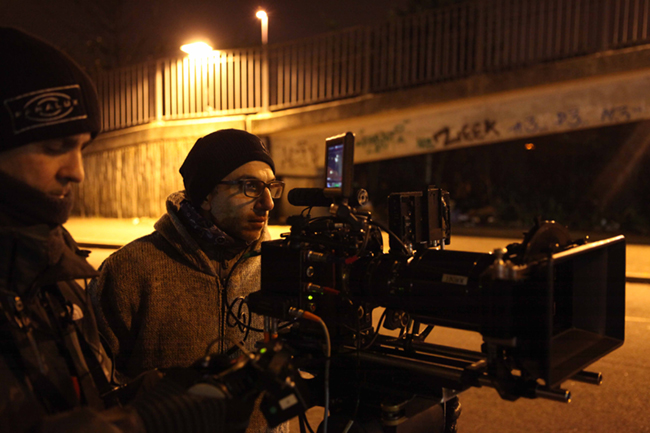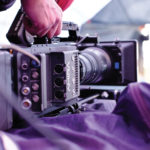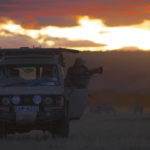
Locke Down
Posted on Jun 11, 2014 by Alex Fice
Haris used reflections to give an almost space travel feel to the journey.
When an A list actor is only available for eight days for a road movie, you’ve got to either have a very short road or an exceptional crew.
It has been called ‘Hamlet On The Highway’, a riveting film and a ‘Tour de Force’ for the actor Tom Hardy. What it isn’t is a tent pole movie, like Thor or Jack Ryan: Shadow Recruit shot by the same DoP, Haris Zambarloukos. Haris has always looked to do smaller independent films and this one struck a chord with him exactly because it wasn’t full of big budget moments. If you read the reviews he also gets plenty of mentions, something he relishes but not as an ego boost. “It’s a rare thing that doesn’t happen very often, for me it’s just the fact that cinematography is observed, that’s a bigger thrill more than me getting mentioned. It’s really rare.”
Locke was shot in eight days in a window that actor Tom Hardy could fit something in. It was solely shot at night on UK motorways and roads. The film was shot in a linear fashion over the week with other actors phoning their parts in (something that usually desribes a less than good performance).
“For three nights we would do the entire performance from beginning to end – 72 pages. That limits the number of shots you can do.”
Haris Zambarloukos, DoP.
Haris read the script and was initially thinking it was a gangster movie. “I was so moved by it, I had never really read anything quite like that. I think one thing that defines a film maker whether they are a cinematographer or an actor, writer or director for me is an attraction to the human condition and to be able to tell a story that evokes something about the human condition. Observation or a comment, anything like that. What drew me to it was that it was a simple, everyday, maybe tragedy maybe not. But it is extremely well balanced and well observed and utterly compelling. No one dies and no one gets killed, there are no gangsters. When I first started reading the script I thought it was going to be a gangster film, you know ‘someone’s in that concrete’. The more I read the more I realised it wasn’t that and if I’m moved by it I’m sure an audience will be. Then you realise now I’m going to sign on to a film that will shoot basically just three square metres, how am I going to do that?
“I force myself not to fall back on things that I already know when I start a film because then you don’t experiment and you don’t try things out and I love testing and thinking out of the box and trying to figure out what could possibly help a story. I had a lot of ideas of things that I wanted to try and I had almost a catalogue of shots that were not used in other car scenes in films that I wanted to do. I just gradually started to work it out. There were also some pre-requisites from Steve (Steven Knight, the director). The idea that for three nights we would do the entire performance from beginning to end, 72 pages – that’s a challenge in the number of shots you can do. So we slowly devised various methods we thought would make it compelling and interesting.
 DoP Haris Zambarloukos.
DoP Haris Zambarloukos.
“Another big concern I had was that I gave them enough variety that could help the editing process. Then on a more maybe subjective point of view to really make the audience feel that they were on this journey – I think we’ve all driven at night and pass a certain point of the motorway and feel like you are almost in a science fiction movie. There are lights reflecting and you do feel like you’re doing space travel and not just going from Birmingham to London. That was another thing that maybe made me try to get the most amount of reflections off the windshield.
“There were certain things that I set up that I knew would be kind of important to me. They are things I have learnt from a lot of car shots. You either compose for the best composition of the actor and maybe the background or to show some part of the car or set-up shots on windshields trying to get the most amount of reflections. The two things don’t often coincide. What I wanted to do was to find a way where I could do both. I’d done some 3D shooting and on a 3D camera rig, you use two cameras and a two-way mirror to point in the same direction. If you remove one camera and use that two-way mirror you can shoot the actor in the car and angle the two-way mirror to get the most amount of reflections from the highway. Effectively what it becomes is like a second windshield but a more controlled windshield. You can aim at on-coming traffic or you could aim it at the neon lights of a shop or something like that. We pretty much used that for a good three quarters of the shots.
“It was all done in-camera, the effects were more random in terms of when it happened, what particular colour or what particular movement happened, what part of the dialogue. But it is in-camera so it couldn’t be shifted around so it couldn’t be changed. So we only used the two-way mirror and not a whole 3D rig and used an adapter which was in-front of the matte box. So we would adjust it for shot, clamp it down and hoped it didn’t get rained on.
“You realise that you are signing on to a film that basically just shoots a certain three metre square space. How am I going to do that?”
Haris Zambarloukos, DoP.
“For the majority of the film we needed to use a low-loader which is a towing vehicle, we didn’t believe that it was a safe idea for Tom to actually drive, say his lines and have three cameras stuck on the windshield. We towed on a truck on the A406 road in the UK. I then attached three cameras to the car. These were RED Epic cameras with C-series anamorphic lenses, a new camera but very old lenses. Those lenses have a good bokeh effect which is when they’re out of focus and how good their flare characteristics are. The digital sensor has very high sensitivity to night lights, the old lenses took the edge off the digital feel and made it look more filmic.
“The rigging of the cameras was a traditional type of grip techniques. Malcolm Hughes was the grip, he’s an exceptional grip, we’ve done this many times. Most of it was hard mounted, sometimes we would use limpet mounts, they were used just for the side view mirror shots on the side of the car. We tried as much as we could to attach to the car, in that way you use the car’s suspension to take out any bumps. If they are attached to the platform behind the truck it can get pretty bumpy. We did some in-car shooting too, they weren’t used as much, in the end we liked the idea of being outside looking in more. When you’re inside the car it felt a lot more static so although I did do a lot of that I think in editorial eventually they used more of the through the windshield shots.
“In the three days of the eight that we had to shoot in we did three nights of three performances and we needed to change cards every 26 minutes so we figured out a loop on the motorway where we could do one length, stop and re-load the cards on the RED cameras then we would change direction on our loop on the motorway. Every time we changed that I would change a camera angle. Our moto was to stick to our guns and be unapologetic about it and keep the same angle for the entire journey. I guess that helped get variety.
We did a couple of other things like shoot with Tom driving and we shot out of the front of the windshield, that was all hand-held with myself and Simon Baker the operator with our focus puller in the car. We did some drive-bys with a double and then we did the entrance from the building site and the last shot that ends the film.
 Haris with one of the three RED Epics used for the movie.
Haris with one of the three RED Epics used for the movie.
“We’ve seen the waste that happens on big budgets film and we can’t afford that but we can do something really special here. It actually worked out really well and was so enjoyable. We learnt a lot from the shooting of Sleuth back on 2007 even the fact of shooting in January/February because that’s the time when the industry is at it’s slowest and so you can get the best crew at that point for these small low budget films. That meticulous planning that we did on Sleuth certainly paid as a form for this.
“I requested an SUV so we could have more space to play with and also to have a sun roof so we could get as much light in as possible. We spent a day at Panavision just picking lenses for the best flare and bokeh abilities. I’d already worked at night with a RED camera so that was an easy choice for me and with it’s size it was perfect for shooting in cars at night. I really think that is the best camera for that job.
“We had to test our lighting rig to match the ambient lights from the motorway. The most traditional way would be to just add some fill light after you get an exposure on the face. I felt that would be a cop out and we needed to do something more intrinsic to the actual driving. We ended up using some very small LED lights that had an RGB component so you could programme colour in to them and we found the best places around the car and in the car to place these.
“We took the footage that we had of driving and wondered how we could programme a chase, basically about 20 various programmes in there of chases that would match or mimic or enhance the lighting effect that would happen for real. These are all programmed in to a computer, set-up on a portable dimmer box and while we were shooting myself and my gaffer Julian White would sit by the monitor and select which of those programmes we would use depending on the light situation at the time. We had a set of programmes which we had already decided upon and made choices on the move.
“After the night shoots the cards would be wrangled by the DIT and then the footage would go to editorial and then our wonderful editor Justine Wright would come back sometimes with some notes saying thing like ‘if you do it again can you make sure I get another front-on angle on that part of the script’. That kind of thing, these notes were really helpful and extremely useful. Also while we would prep on the afternoon for the evening we would watch the previous day’s rushes.
“I had done a test grade with the test material so I had an idea of what I wanted it to look like. I always do a little bit of a grade before I start a film so that everyone is on the same page. We did devise a LUT from that which was used for dailies and then it was a very quick grade which we did at Company 3 in London. We had a very basic set-up, a few windows, maybe in some places it was a little darker than I had hoped so it was just a balancing act. There was no forced look on the film, those colours are the colours that came from the streets or from our lights. We didn’t put a tint on it or an overall hue. One of the other things when you use a lot of colour in an image is it’s always really good for the eye to have a reference for something that is clear white so in our programme, in our chase I always make sure that every few seconds a round white light would go through. It just clears your eye’s palette and helps you accept colour. Your eye references that and it’s very useful.”

















